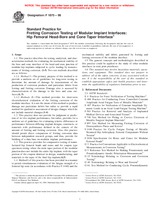Potřebujeme váš souhlas k využití jednotlivých dat, aby se vám mimo jiné mohly ukazovat informace týkající se vašich zájmů. Souhlas udělíte kliknutím na tlačítko „OK“.
ASTM F1875-98
Standard Practice for Fretting Corrosion Testing of Modular Implant Interfaces: Hip Femoral Head-bore and Cone Taper Interface
Automaticky přeložený název:
Standardní praxe pro vibrační koroze testování modulárního Implant Rozhraní : Hip hlavice stehenní kosti , vrtání a Cone Kužel Interface
NORMA vydána dne 10.4.1998
Informace o normě:
Označení normy: ASTM F1875-98
Poznámka: NEPLATNÁ
Datum vydání normy: 10.4.1998
Kód zboží: NS-51918
Počet stran: 6
Přibližná hmotnost: 18 g (0.04 liber)
Země: Americká technická norma
Kategorie: Technické normy ASTM
Anotace textu normy ASTM F1875-98 :
Keywords:
bore and cone, debris, fretting corrosion, modular total hips, ICS Number Code 11.040.40 (Implants for surgery, prothetics and orthotics)
Doplňující informace
| 1. Scope | ||||||||||||||||||||||||||||||
|
1.1 This practice describes the testing, analytical, and characterization methods for evaluating the mechanical stability of the bore and cone interface of the head and stem junction of modular hip implants subjected to cyclic loading by measurements of fretting corrosion. (1-5) Two test methods described are as follows: 1.1.1 Method I-The primary purpose of this method is to provide a uniform set of guidelines for long-term testing to determine the amount of damage by measurement of the production of corrosion products and particulate debris from fretting and fretting corrosion. Damage also is assessed by characterization of the damage to the bore and cone surfaces. (4,5) 1.1.2 Methods II-This method provides for short-term electrochemical evaluation of the fretting corrosion of the modular interface. It is not the intent of this method to produce damage nor particulate debris but rather to provide a rapid method for qualitative assessment of design changes which do not include material changes. (1-4) 1.2 This practice does not provide for judgment or prediction of in vivo implant performance, but rather, provides for a uniform set of guidelines for evaluating relative differences in performance between differing implant designs, constructs, or materials with performance defined in the context of the amount of fretting and fretting corrosion. Also, this practice should permit direct comparison of fretting corrosion data between independent research groups, and thus, provide for building of a data base on modular implant performance. 1.3 This practice provides for comparative testing of manufactured hip femoral heads and stems and for coupon type specimen testing where the male taper portion of the modular junction does not include the entire hip implant, with the taper portion of the coupon identical in design, manufacturing, and materials to the taper of the final hip implant. (4,5) 1.4 Method I of this practice has been provided in a manner to permit simultaneous evaluation of the fatigue strength of a femoral hip stem (in accordance with Practice F1440) and the mechanical stability and debris generated by fretting and fretting corrosion of the modular interface. 1.5 The general concepts and methodologies described in this practice could be applied to the study of other modular interfaces in total joint prostheses. 1.6 This standard may involve hazardous materials, operations, and equipment. This standard does not purport to address all of the safety concerns, if any, associated with its use. It is the responsibility of the user of this standard to establish appropriate safety and health practices and determine the applicability of regulatory limitations prior to use. |
||||||||||||||||||||||||||||||
| 2. Referenced Documents | ||||||||||||||||||||||||||||||
|
Odebírejte informace o nově vydaných normách ZDARMA:
Chcete pravidelně odebírat informace o nově vycházejících normách z celého světa a to zcela zdarma?
Přihlašte se k odběru. Vše je velice jednoduché a absolutně ZDARMA.
Na výběr máte vydavatele z celého světa.




 Cookies
Cookies
